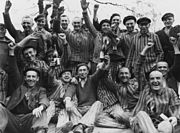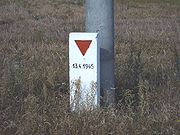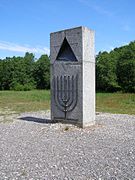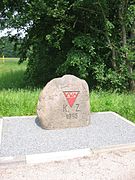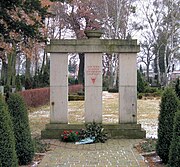Nazi concentration camp badge
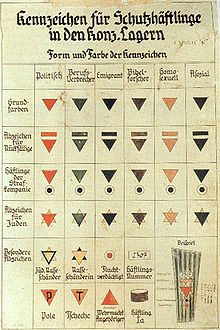
Nazi concentration camp badges were colored pieces of fabric used by the Nazis to identify concentration camp prisoners during World War II.
Prisoners had to sew these badges onto their uniform jackets and pants. The badges used a color coding system to show why each prisoner had been sent to the camp.[1] Different colors and shapes had different meanings. The prisoners were required to wear these badges of shame.
The badges helped guards assign tasks to the prisoners. If a prisoner's badge marked them as an escape suspect, the SS would not allow them to work outside the camp fence. If a prisoner had an F on their badge (meaning they were French), guards could force them to help translate instructions to new prisoners from France. If a guard looked at a prisoner and saw a green badge, the guard knew right away that the person was a convicted criminal. Guards often assigned these "green triangles" to be kapos. These were prisoners who were assigned to help the SS run the camps. Many kapos used abuse and violence to control other prisoners.
Some historical monuments use images of these identification badges to symbolize the victims of the concentration camps.
Today, some people use a pink triangle emblem to symbolize gay rights.
Badge coding system[change | change source]

Different camps used different systems of badges. In the later stages of World War II, the use of badges became less common in some camps. The following description is based on the badge coding system used in the Dachau concentration camp. This camp had one of the more detailed coding systems.
Most badges were inverted triangles. (This meant the widest part of the triangle was at the top of the shape, not the bottom.) The Nazis chose this shape because it looked like triangular road hazard signs that are common in Germany.
Single triangles[change | change source]
Single triangles of different colors identified different types of prisoners.
Black triangles[change | change source]
The Nazis made many different types of prisoners wear black triangles. The black triangle identified people who the Nazis called 'asocial' (asozial) or 'work-shy' (arbeitsscheu). These included alcoholics, drug addicts, homeless people, beggars, people with disabilities, prostitutes,[2][3] lesbians,[4] pacifists, and people who refused to be conscripted into the German armed forces.
Black triangles also marked Roma and Sinti people. They wore the black triangle with a Z on it (for Zigeuner, meaning Gypsy).[5] Romani men were later assigned a brown triangle. However, Romani women always wore black triangles. The Nazis believed many stereotypes about Romani women. They thought these women were petty criminals (prostitutes, kidnappers, and fortune tellers). For this reason, the Nazis never stopped calling Romani women "asocial." Many of these women were forcibly sterilized.[6]
The Nazis also used the black triangle to identify people with mental illnesses and "mentally disabled" people. Written on their badges was the word Blöd, which means "stupid."[7][8] This category included people with autism. (At that time, autism was called Asperger's Syndrome, named after Austrian pediatrician Hans Asperger, who was involved with the Nazis). [9][10] People with schizophrenia and epilepsy[6] also wore black triangles. Instead of being sent to concentration camps, many people in this group were forcibly sterilized, shot, or gassed in psychiatric institutions as part of the T4 Euthanasia Program.[11]
Other people with disabilities, like diabetes, also had to wear the black triangle. (The Nazis thought that diabetes was a 'Jewish disease.' There was no evidence for this claim. Instead, it was a result of antisemitism in medicine, science, and culture.[12])
Red triangles[change | change source]
Red triangles identified political prisoners. These included:
- Social democrats
- Liberals
- Socialists
- Communists
- Anarchists
- Trade unionists
- Freemasons
- Non-Jews who helped Jewish people
Green triangles[change | change source]
Green triangles identified convicts and criminals (who often worked as kapos).
Blue triangles[change | change source]
Blue triangles identified foreign forced laborers and emigrants from Nazi-controlled countries.[13] This category included apatrides (stateless people, who were not citizens of any country). Spanish refugees from Francoist Spain belonged to this category. Because these people did not support the dictatorship of Francisco Franco, the Spanish government cancelled their citizenship.
Purple triangles[change | change source]
Purple triangles identified the Nazis' religious enemies. Over 99% of these people were Jehovah's Witnesses. Members of other small pacifist religious groups also wore purple triangles.[notes 1]
Pink triangles[change | change source]
Pink triangles usually identified homosexual men and others who the Nazis called homosexual (like bisexual men and transgender women).[14][15][16] The Nazis also used pink triangles to identify sexual offenders, paedophiles, and zoophiles.[17] The Nazis forcibly sterilized many people in this group.[6]
Uninverted red triangles[change | change source]
Uninverted red triangles identified several groups of people:
- Enemy prisoners of war (called Sonderhäftling, meaning 'special detainee')
- Spies and traitors (called Aktionshäftling, meaning 'activities detainee')
- Military deserters or criminals (Wehrmachtsangehöriger, meaning 'service member')
- Some examples of the single triangle design at Nazi camps
-
Single-triangle badges in various colors visible on Sachsenhausen concentration camp prisoners
-
Single triangles visible on Sachsenhausen detainees
-
This badge marked an inmate as a Jehovah's Witness
-
Red emblems on a Dachau detainee's clothing marking them as a political prisoner
-
More Sachsenhausen detainees with badges on their uniforms
-
Black triangles are visible on the trousers of these Romani detainees at Dachau
-
A United States Army photo of Austrian economist and financial specialist Benedikt Kautsky, a political prisoner, after he was liberated from Buchenwald
-
The liberated Neuengamme survivor standing on the right has a triangle patch with a top-bar
Double triangles[change | change source]
The Nazis used double-triangle badges to identify Jewish prisoners. These badges were made of two overlapping triangles. These two triangles formed a Star of David, a Jewish symbol.
- A red inverted triangle superimposed upon a yellow one represented a Jewish political prisoner.
- A green inverted triangle superimposed upon a yellow one represented a Jewish habitual criminal.
- A purple inverted triangle superimposed upon a yellow one represented a Jehovah's Witness of Jewish descent.[18]
- A pink inverted triangle superimposed upon a yellow one represented a Jewish "sexual offender", usually a gay or bisexual man.
- A black inverted triangle superimposed upon a yellow one represented 'asocial' and 'work-shy' Jews.
- A voided black inverted triangle superimposed over a yellow triangle represented a Jew convicted of miscegenation and labelled as a Rassenschänder (race defiler).
- A yellow inverted triangle superimposed over a black triangle represented an Aryan woman convicted of miscegenation and labelled as a Rassenschänder (race defiler).
People who wore inverted pink, green, voided black, and yellow double badges were usually convicted by criminal courts before they were sent to concentration camps.
Some double-triangle badges identified non-Jews. For example, at Mauthausen, Spanish Republicans had to wear a blue inverted triangle superimposed upon a red one.[19]
- Some period examples of the double triangle design at Nazi camps
-
A Sachsenhausen detainee (the man wearing glasses) wears a two-color identification badge
-
Jewish people with disabilities at Buchenwald in 1938. They wore black triangles on a yellow triangles, marking them as 'asocial' Jews
-
Part of a Dachau roll call; day badges are visible on the detainees' uniforms
-
A Sachsenhausen detainee's uniform. The red triangle atop a yellow triangle (at bottom left) marked the prisoner as a Jewish political enemy
Distinguishing marks[change | change source]
In addition to color-coding, non-German prisoners were marked by the first letter of the German name for their home country or ethnic group. Red triangle with a letter, for example:
- B identified Belgians (Belgier)
- E stood for English (Engländer)
- F identified French people (Franzosen)
- H stood for people from Holland (Holländer)
- I identified Italians (Italiener)
- J marked Yugoslavs (Jugoslawen)[20]
- N identified Norwegians (Norweger)
- P identified Poles (Polen)
- S marked Spanish Republicans (republikanische Spanier)
- T identified Czechs (Tscheche)
- U marked Hungarians (Ungarn)
- Z (next to a black triangle) marked Roma people (Zigeuner)
Polish emigrant laborers originally wore a purple diamond with a yellow backing. A letter P (for Polen) was cut out of the purple cloth to show the yellow backing beneath.
Furthermore, repeat offenders (rückfällige, meaning recidivists) had to wear bars over their stars or triangles. Different colors represented different crimes:
- A political prisoner would have a red bar over their star or triangle.
- A professional criminal would have a green bar.
- A foreign forced laborer would not have a blue bar (because they would be imprisoned until the end of the war. However, these people might have a different coloured bar if they belonged to another category of prisoners.
- A Jehovah's Witness would have a purple bar.
- A homosexual or sex offender would have a pink bar.
- An asocial would have a black bar.
- Roma and Sinti would usually be incarcerated in special sub-camps until they died, so they usually did not receive a repeat stripe.
Later in the war (late 1944), to save cloth, Jewish prisoners wore a yellow bar over a regular point-down triangle to indicate their status. For instance, regular Jews would wear a yellow bar over a red triangle, while Jewish criminals would wear a yellow bar over a green triangle.
- Some period examples of nationality-letter marking at Nazi camps
-
The scientist Dr. Joseph Brau had to wear this badge in Buchenwald, marking him as a French political enemy
-
Another photo of Dr. Joseph Brau's Buchenwald uniform
-
This badge marked a Polish political enemy
-
At Stutthof, Lidia Główczewska had to wear this badge. It identified her as prisoner number 29659 and marked her as a Polish political enemy
-
Auschwitz detainee Ignacy Kwarta wears a red P-triangle, meaning a Polish political enemy
-
Dutch Jews at Mauthausen wearing a yellow star and the letter N (for Niederländer ).[21]
-
A Sachsenhausen-issued red F emblem for a French political enemy
-
Emblems were also used on some detainee identification cards. At Mauthausen, this card identified the scientist Jerzy Kaźmirkiewicz. The P-triangle on the card marks him as a Polish political enemy
-
Dachau survivors toast their liberation as the man standing in center between the bottles wears a P-triangle.
-
A liberated Bergen-Belsen survivor (left) with a late war ersatz. Instead of wearing a cloth badge, this survivor had to wear a large N on her outer clothes
Table of camp inmate markings[change | change source]
| Politisch Political prisoner |
Berufsverbrecher Professional criminal |
Emigrant Foreign forced laborer |
Bibelforscher Bible Student (Jehovah's Witnesses) |
Homosexuell Male homosexual/sex offender |
Arbeitsscheu/Asozial Work-shy/Asocial |
Zigeuner Gypsy (Roma or Sinti male) | |
|---|---|---|---|---|---|---|---|
| Basic colours | |||||||
| Markings for repeaters | 
|

|

|

|

|

|

|
| Inmates of Strafkompanie (punishment companies) | 
|

|

|

|

|

|

|
| Markings for Jews | 
|

|

|

|

|

|

|
| Political prisoner nationality markings The capital letter of the name of the country on a red triangle |
Belgier (Belgian) | Tscheche (Czech) | Franzose (French) | Pole (Polish) | Spanier (Spanish) | ||

|
|||||||
| Special markings | Jüdischer Rassenschänder Jewish race defiler |
Rassenschänderin Female race defiler |
Escape suspect | Häftlingsnummer Inmate number |
Kennzeichen für Funktionshäftlinge Special inmates' brown armband |
Enemy POW or deserter | |

|

|

|

|
||||
| Example | 
|
Marks were worn in descending order as follows: inmate number, repeater bar, triangle or star, member of penal battalion, escape suspect. In this example, the inmate is a Jewish convict with multiple convictions, serving in a Strafkompanie (penal unit) and who is suspected of trying to escape. | |||||
Postwar use[change | change source]
Triangles appear on many postwar memorials to the Nazis' victims. These shapes represent the identification patches used in the camps. Sometimes, plain or colored triangles represent all categories of inmates. Often, inverted red triangles represent all victims of the concentration camps, including also the non-Jewish victims like Slavs, Poles, communists, homosexuals, Roma and Sinti, people with disabilities, Soviet POWs, and Jehovah's Witnesses.
Some Holocaust memorials use more specific triangles. An inverted pink triangle symbolizes gay victims. A yellow and/or non-inverted triangle generally stands for Jewish victims. Some monuments also include badges with nationality letters.
- Some examples of camp triangle emblems on monuments and related uses
-
A memorial at Sachsenhausen decorated with red triangles
-
A Dora Todesmarsch (death march) roadside tablet marked only with the date and a red triangle
-
A colorless triangle at the Klooga Jewish victims' memorial
-
A red triangle on a historical marker. The marker shows the route prisoners were forced to take on the Buchenwald death march (Todesmarsch).
-
Red triangle on a historical marker for Sachsenhausen death march victims
-
Inverted triangle on a monument for Ravensbrück death march victims, in the village of Grabow-Below
-
Triangle symbol on a Wöbbelin memorial stone
-
This boulder in Lindenring honors 2,000 women victims of Ravensbrück
-
Pink triangle on a memorial for people on the Cap Arcona prison ship. About 7,000 people died after the Royal Air Force bombed the ship
-
Triangle symbol at the Neustadt-Glewe concentration camp memorial
-
F-triangle at Mauthausen-Gusen, honoring French victims
-
A B-triangle incorporated into the Belgian Political Prisoner's Cross
-
This F-triangle at Hinzert honors French victims, especially the victims killed after Hitler's Nacht und Nebel directive
-
A monument to Neuengamme victims in Hamburg. The letters KZ are not nationality-letters; they are the German abbreviation for Konzentrationslager (concentration camp)
-
Triangular symbol on a memorial to victims killed at Genshagen (right panel)
-
A P-triangle at a Zgorzelec memorial
-
P-triangle on the Polish medal for camp victims
-
Various badges on a Dachau memorial
-
Pink triangle (Rosa Winkel in German) memorial for gay men killed at Buchenwald
-
This pink triangle plaque in the Berlin Nollendorfplatz subway station honors gay male victims
-
Amsterdam's Homomonument uses pink triangles symbolically to memorialize gay men killed in the Holocaust. The pink triangles also honor victims of anti-gay violence.
2020 Trump campaign[change | change source]
In June 2020, Donald Trump was running for re-election. His campaign posted an advertisement on Facebook which said that "Dangerous MOBS of far-left groups are running through our streets and causing absolute mayhem." The ads identified these groups as "ANTIFA" and used an image of a downward-pointing red triangle. These ads appeared on the Facebook pages of Donald Trump, the Trump campaign, and Vice President Mike Pence. Many observers compared the graphic to the symbol used by the Nazis for identifying political prisoners such as communists, social democrats and socialists. Many noted that there were 88 ads. Neo-Nazis use the number 88 as an abbreviation for the Nazi salute Heil Hitler. (The letter H is the eighth in the alphabet, so 88 stands for "HH.")[22][23][24]
Facebook removed the campaign ads that used the red triangle symbol, saying that its use in this context violated their policy against "organized hate".[25][26][27][28][29][30] The Trump campaign's communications director wrote that "The red triangle is a common Antifa symbol used in an ad about Antifa." However, the historian Mark Bray, who wrote Antifa: The Anti-Fascist Handbook, disagreed. He said that the symbol Antifa in the United States does not use this symbol.[31]
References[change | change source]
Informational notes
- ↑ Johannes S. Wrobel (June 2006). "Jehovah's Witnesses in National Socialist Concentration Camps, 1933–45". Religion, State & Society. Vol. 34. No. 2. pp. 89–125. "The concentration camp prisoner category 'Bible Student' at times apparently included a few members from small Bible Student splinter groups, as well as adherents of other religious groups which played only a secondary role during the time of the National Socialist regime, such as Adventists, Baptists and the New Apostolic community (Garbe 1999, pp. 82, 406; Zeiger, 2001, p. 72). Since their numbers in the camps were quite small compared with the total number of Jehovah's Witness prisoners, I shall not consider them separately in this article. Historian Antje Zeiger (2001, p. 88) writes about Sachsenhausen camp: 'In May 1938, every tenth prisoner was a Jehovah's Witness. Less than one percent of the Witnesses included other religious nonconformists (Adventists, Baptists, pacifists), who were placed in the same prisoner classification.'"
Citations
- ↑ "The History Place – Holocaust Timeline: Nazis Open Dachau Concentration Camp". historyplace.com. Retrieved 27 March 2018.
- ↑ Claudia Schoppmann (1990). Nationalsozialistische Sexualpolitik und weibliche Homosexualität. Dissertation, FU Berlin. Centaurus, Pfaffenweiler 1991 (revisited 2nd edition 1997). ISBN 3-89085-538-5
- ↑ "Black triangle women". 1 February 2001. Archived from the original on 12 February 2009. Retrieved 2 February 2008.
- ↑ Elman PhD, R. Amy (1996). "Triangles and Tribulations: The Politics of Nazi Symbols". Journal of Homosexuality. 30 (3): 1–11. doi:10.1300/J082v30n03_01. ISSN 0091-8369. PMID 8743114.
- ↑ "Glossary". jewishvirtuallibrary.org. Retrieved 27 March 2018.
- ↑ 6.0 6.1 6.2 "Nazi Persecution of the Mentally & Physically Disabled". www.jewishvirtuallibrary.org. Retrieved 2021-12-29.
- ↑ "Badges". holocaustrevealed.org. Retrieved 27 March 2018.
- ↑ Edelheit, Abraham J.; Edelheit, Hershel (2018-10-08). History of the Holocaust. New York: Routledge. doi:10.4324/9780429493737. ISBN 9780429493737. S2CID 160553505.
- ↑ Sheffer, Edith (2018). Asperger's children: the origins of autism in Nazi Vienna. New York. ISBN 978-0-393-60964-6. OCLC 1005104504.
{{cite book}}: CS1 maint: location missing publisher (link) - ↑ Wadman, Meredith (2018-06-15). "Asperger's chilling complicity". Science (Review). 360 (6394): 1192–1193. Bibcode:2018Sci...360.1192W. doi:10.1126/science.aat9801. ISSN 0036-8075. S2CID 49208551.
- ↑ Torrey, E. Fuller; Yolken, Robert H. (2010-01-01). "Psychiatric Genocide: Nazi Attempts to Eradicate Schizophrenia". Schizophrenia Bulletin. 36 (1): 26–32. doi:10.1093/schbul/sbp097. ISSN 0586-7614. PMC 2800142. PMID 19759092.
- ↑ Tuchman, Arleen Marcia (January 2011). "Diabetes and RACE A Historical Perspective". American Journal of Public Health. 101 (1): 24–33. doi:10.2105/AJPH.2010.202564. ISSN 0090-0036. PMC 3000712. PMID 21148711.
- ↑ Gabriele Hammermann, Stefanie Pilzweger-Steiner (2018) KZ-Gedenk·stätte Dachau: Ein Rund·gang in Leichter Sprache. p. 72
- ↑ Cristian Williams. "2008 Houston Transgender Day of Remembrance: Transgenders and Nazi Germany". tgdor.org. Archived from the original on 16 September 2018. Retrieved 27 August 2018.
- ↑ "Canadian National Holocaust Monument / Studio Libeskind". arcspace.com. Archived from the original on 27 December 2019. Retrieved 30 August 2018.
- ↑ "Illuminating the Darkness". outsmartmagazine.com. November 2012. Retrieved 30 August 2018.
- ↑ Richard Plant (1988). The Pink Triangle: The Nazi War Against Homosexuals. Owl Books. ISBN 0-8050-0600-1.
- ↑ Note that since Jew was defined along racial lines, such as by the Nuremberg Laws, Jews could be classified as Jehovah's Witnesses.
- ↑ "De Tomelloso a Mauthausen". entomelloso.com. 12 January 2017. Retrieved 27 March 2018.
- ↑ J. Beoković (19 October 2009). "У Аушвицу, на вест о ослобођењу Београда". politika.rs (in Serbian). Retrieved 26 October 2018.
- ↑ Stein, Harry (2007). Buchenwald memorial (ed.). Konzentrationslager Buchenwald 1937-1945. Begleitband zur ständigen historischen Ausstellung (in German) (5th ed.). Göttingen: Wallstein-Verlag. pp. 81–83. ISBN 978-3-89244-222-6.
- ↑ Breland, Ali. "Nazis put this symbol on political opponents' arms. Now Trump is using it". Mother Jones. Retrieved 2020-06-19.
- ↑ Morrison, Sara (2020-06-18). "Facebook takes down another Trump campaign ad, this time for Nazi imagery". Vox. Retrieved 2020-06-19.
- ↑ Rodrigo, Chris Mills (2020-06-18). "Facebook takes down Trump ads featuring symbol used by Nazis to mark political prisoners". TheHill. Retrieved 2020-06-19.
- ↑ Shannon, Joel. "Nazis used red triangles to mark political prisoners. That symbol is why Facebook banned a Donald Trump reelection campaign ad". USA TODAY. Retrieved 2021-12-22.
- ↑ "The History of The Concentration Camp Badge in a Team Trump Ad For Facebook". Newsweek. 18 June 2020.
- ↑ Feldman, Ari (18 June 2020). "Facebook removes Trump ad that identifies Antifa with red triangle similar to Nazi symbol". The Forward.
- ↑ "Trump campaign accused of using a Nazi symbol in Facebook ad". The Daily Dot. 18 June 2020.
- ↑ "Facebook removes Trump ads for violating 'organized hate' policy". NBC News. Retrieved 2020-06-18.
- ↑ Stanley-Becker, Isaac. "Facebook removes Trump ads with symbol once used by Nazis to designate political prisoners". Washington Post. Retrieved 2020-06-18.
- ↑ Karni, Annie (June 18, 2020). "Facebook removes Trump ads displaying symbol used by Nazis". The New York Times.
Bibliography
- Richard Plant (1988). The Pink Triangle: The Nazi War Against Homosexuals. Owl Books. ISBN 0-8050-0600-1.
- Camp badge chart at historyplace.com.
- Additional camp badge chart Archived 2021-03-04 at the Wayback Machine.
Other websites[change | change source]
- United States Holocaust Memorial Museum. Classification system in Nazi concentration camps.
- Stars, triangles and markings. Jewish Virtual Library.
- Gay Prisoners in Concentration Camps as Compared with Jehovah's Witnesses and Political Prisoners. Ruediger Lautmann.



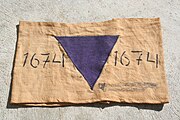



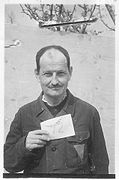

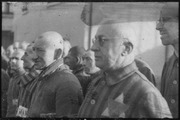
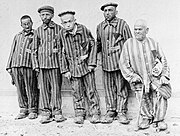






![Dutch Jews at Mauthausen wearing a yellow star and the letter N (for Niederländer ).[21]](http://upload.wikimedia.org/wikipedia/commons/thumb/8/86/Buchenwald_Prisoners_83718.jpg/180px-Buchenwald_Prisoners_83718.jpg)


